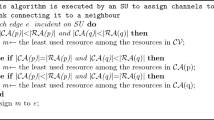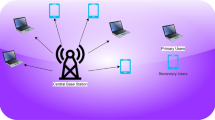Abstract
A new problem of spectrum scarcity has emerged due to the incredible technological advances in wireless communication. The spectrum scarcity issue is a bottleneck for the next generation of wireless communications. Therefore, efficient spectrum utilization has attracted considerable attention. This paper proposes a novel method of utilizing the white spaces in the licensed spectrum while ensuring the incumbent licensees’ rights. The protocol predicts the incumbents’ arrival using a historical prediction method and protects the incumbent users from the interference of opportunistic spectrum users. Distributed sensing is used to determine the network wide spectrum opportunity. The channel access delay in the proposed protocol is evaluated by simulation and mathematical analysis. The protocol has the advantages of a decentralized system, flexibility and low computing complexity. The simulations show that the protocol outperforms the existing opportunistic spectrum-sharing, media-access-control protocols in terms of the goodput and delay.








Similar content being viewed by others
References
Chiang, R. (2009). Feasibility investigation of cognitive radio systems. PhD dissertation. New Zealand: The University of Auckland.
Renk, T., Kloeck, C., & Jondral, F. K. (2007). A cognitive approach to the detection of spectrum holes in wireless networks. In IEEE consumer communications and networking conference. Las Vegas, USA.
Cabric, D., Mishra, S. M., Willkomm, D., Broderson, R. W., & Wolisz, A. (2005). A cognitive radio approach for usage of virtual unlicensed spectrum. In 14th IST mobile wireless communications summit. Dresden, Germany.
Walko, J. (2005). Cognitive radio. IEE Review, 51(5), 34–37.
FCC. (2002). Spectrum policy task force report. In FCC, Technical Report Series. ET Docket No. 02–155, Nov 2002.
De Domenico, A., Strinati, E. C., & Di Benedetto, M. (2012). A survey on MAC strategies for cognitive radio networks. IEEE Communications Surveys & Tutorials, 14(1), 21–44.
Cormio, C., & Chowdhury, K. R. (2009). A survey on MAC protocols for cognitive radio networks. Ad Hoc Networks, 7(7), 1315–1329.
IEEE Standard for Information Technology-Telecommunications and information exchange between systems-Wireless Regional Area Networks (WRAN)-Specific requirements-Part 22: Cognitive Wireless RAN Medium Access Control (MAC) and Physical Layer (PHY) Specs.: Policies and Procedures for Operation in the TV Bands. 16 June 2011.
Wu, S.-L., Lin, C.-Y., Tseng, Y.-C., & Sheu J.-P. (2000). A new multi-channel MAC protocol with on-demand channel assignment for multi-hop mobile ad hoc networks. In ISPAN 2000 (pp. 232–237). Texas, USA.
Nan, H., Hyon, T., & Yoo, S. (2007). Distributed coordinated spectrum sharing MAC protocol for cognitive radio. In IEEE symposium on new Frontiers in DySpan 2007 (pp. 240–249). Dublin, Ireland.
Timmers, M., Pollin, S., Dejonghe, A., Van der Perre, L., & Catthoor, F. (2010). A distributed multichannel MAC protocol for multihop cognitive radio networks. IEEE Transactions on Vehicular Technology, 59(1), 446–459.
So, J., & Vaidya, N. (2004). Multi-channel MAC for ad hoc networks: Handling multi-channel hidden terminals using a single transceiver. In MobiHoc 2004 (pp. 222–233). New York, USA.
IEEE Standard for Information Technology-Telecommunications and Information Exchange Between Systems-Local and Metropolitan Area Networks-Specific Requirements Part II: Wireless LAN Medium Access Control (MAC) and Physical Layer (PHY) Specs., TG 802.11, 2003.
Kamruzzaman, S. M., Hamid, M. A., & Abdullah-Al-Wadud, M. (2010). An energy-efficient MAC protocol for QoS provisioning in cognitive radio ad hoc networks. Radioengineering, 19(4), 567–578.
Krunzj, M., & Manzi, D. (2011). Channel access and traffic control for dynamic-spectrum networks with single-transmit, dual-receive radios. Computer Communications, 34(8), 935–947.
Jia, J., Zhang, Q., & Shen, X. (2008). HC-MAC: A hardware-constrained cognitive MAC for efficient spectrum management. IEEE Journal on Selected Areas in Communications, 26(1), 106–117.
Su, H., & Zhang, X. (2008). Cross-layer based opportunistic MAC protocols for QoS provisionings over cognitive radio wireless networks. IEEE Journal on Selected Areas in Communications, 26(1), 118–129.
Ma, L., Han, X., & Shen, C.-C. (2005). Dynamic open spectrum sharing for wireless ad hoc networks. In IEEE DySPAN 2005 (pp. 203–213). Baltimore, USA.
Mitola, J., & Maguire, G. (1999). Cognitive radio: Making software radios more personal. IEEE Personal Communications, 6(4), 13–18.
Haykin, S. (2005). Cognitive radio: Brain-empowered wireless communications. IEEE Journal on Selected Areas in Communications, 23(2), 201–220.
Song, J., Xue, J., Feng, Z., Zhang, P., & Liu, Z. (2010). Optimal cooperative spectrum sensing strategies in cognitive radio networks. In IEEE VTC 2010 (pp. 1–6). Taipei.
Quan, Z., Cui, S., & Sayed, A. H. (2007). An optimal strategy for cooperative spectrum sensing in cognitive radio networks. In IEEE GLOBECOM 2007 (pp. 2947–2951). Washington DC, USA.
Ganesan, G., & Li, Y.G. (2005). Cooperative spectrum sensing in cognitive radio networks. In IEEE DySPAN 2005 (pp. 137–143). Baltimore, USA.
Zhu, X., Shen, L., & Yum, T.-S. P. (2007). Analysis of cognitive radio spectrum access with optimal channel reservation. IEEE Communications Letters, 11(4), 304–306.
Barowski, Y. D., & Biaz, S. (2004). The performance analysis of IEEE 802.11 under unsaturated traffic conditions. Technical Report, CSSE04-09. (pp. 1–12). Alabama, USA: Auburn University.
Ross, S. M. (2002). Probability models for computer science. New York: Academic Press.
The network simulator—ns-2. Internet: http://www.isi.edu/nsnam/ns/. Accessed 17 June 2009.
Acknowledgments
This research was supported by Basic Science Research Program through the National Research Foundation of Korea (NRF) funded by the Ministry of Science, ICT & Future Planning (NRF-2012R1A1B4000536).
Author information
Authors and Affiliations
Corresponding author
Rights and permissions
About this article
Cite this article
Joshi, G.P., Nam, S.Y. & Kim, S.W. Decentralized Predictive MAC Protocol for Ad Hoc Cognitive Radio Networks. Wireless Pers Commun 74, 803–821 (2014). https://doi.org/10.1007/s11277-013-1322-6
Published:
Issue Date:
DOI: https://doi.org/10.1007/s11277-013-1322-6




